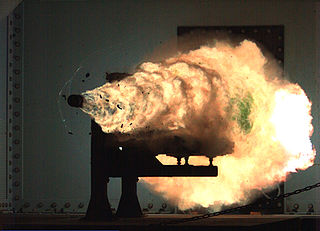Related Research Articles

The Defense Advanced Research Projects Agency (DARPA) is an agency of the United States Department of Defense responsible for the development of emerging technologies for use by the military.

The Sandia National Laboratories (SNL), managed and operated by the National Technology and Engineering Solutions of Sandia, is one of three National Nuclear Security Administration research and development laboratories in the United States. Their primary mission is to develop, engineer, and test the non-nuclear components of nuclear weapons and high technology. Headquartered in Central New Mexico near the Sandia Mountains, on Kirtland Air Force Base in Albuquerque, Sandia also has a campus in Livermore, California, next to Lawrence Livermore National Laboratory, and a test facility in Waimea, Kauai, Hawaii.

A railgun is a linear motor device, typically designed as a weapon, that uses electromagnetic force to launch high velocity projectiles. The projectile normally does not contain explosives, instead relying on the projectile's high speed, mass, and kinetic energy to inflict damage. The railgun uses a pair of parallel conductors (rails), along which a sliding armature is accelerated by the electromagnetic effects of a current that flows down one rail, into the armature and then back along the other rail. It is based on principles similar to those of the homopolar motor.
A smart bullet is a bullet that is able to do something other than simply follow its given trajectory, such as turning, changing speed or sending data.
Defence Science and Technology (DST) is part of the Australian Department of Defence dedicated to providing science and technology support for Australia's defence and national security needs. It is Australia's second largest government-funded science organisation after the CSIRO. The agency's name was changed from Defence Science and Technology Organisation (DSTO) to Defence Science and Technology on 1 July 2015.

The XM25 Counter Defilade Target Engagement (CDTE) System, also known as the Punisher and Individual Semiautomatic Air Burst System was an airburst grenade launcher with programmable ammunition derived from the XM29 OICW. It was fielded to soldiers serving in the War in Afghanistan in 2010, after which malfunctions and 2013 program budget cuts delayed official entry into service, planned for early 2017. In early 2017, the contract with Orbital ATK was cancelled, calling the future of the entire program into question. The program was officially terminated on 24 July 2018.
The Combat Capabilities Development Command (CCDC) C5ISR Center, formerly the Communications-Electronics RD&E Center (CERDEC), is the United States Army information technologies and integrated systems center. CCDC C5ISR Center is headquartered at Aberdeen Proving Ground in Maryland, with activities at Fort Belvoir in Virginia and Joint Base McGuire-Dix-Lakehurst in New Jersey.

The Army Research Laboratory (ARL) is the U.S. Army's corporate research laboratory. ARL is headquartered at the Adelphi Laboratory Center (ALC) in Adelphi, Maryland. Its largest single site is at Aberdeen Proving Ground, Maryland. Other major ARL locations include Research Triangle Park, North Carolina, White Sands Missile Range, New Mexico, Orlando, Florida, and NASA's Glenn Research Center, Ohio and Langley Research Center, Virginia. ARL also has regional sites in Los Angeles, Chicago, College Station, TX, and Boston.

Developed by Northrop Grumman, the Integrated Meteorological System is the meteorological component of the Intelligence and Electronic Warfare (IEW) an element of the Army Battle Command System (ABCS). IMETS provides Army commanders at all echelons with an automated weather system to receive, process, and disseminate weather observations, forecasts, and weather and environmental effects decision aids to all Battlefield Operating Systems (BOS). IMETS is a mobile, tactical, automated weather data receiving, processing and dissemination system. The IMETS is an Army-furnished and maintained system operated by US Air Force battlefield weather team personnel. It uses US Air Force and Army developed software to provide a total weather system to support the Army. The Integrated Weather Effects Decision Aid (IWEDA) software, originally developed by the U.S. Army Research Laboratory (ARL) in 1992, has been fielded on IMETS since 1997 to provide tactical weather support to the U.S. Army.
Radar MASINT is a subdiscipline of measurement and signature intelligence (MASINT) and refers to intelligence gathering activities that bring together disparate elements that do not fit within the definitions of signals intelligence (SIGINT), imagery intelligence (IMINT), or human intelligence (HUMINT).
Business process management (BPM) is a discipline in operations management in which people use various methods to discover, model, analyze, measure, improve, optimize, and automate business processes. Any combination of methods used to manage a company's business processes is BPM. Processes can be structured and repeatable or unstructured and variable. Though not required, enabling technologies are often used with BPM.

A precision-guided munition is a guided munition intended to precisely hit a specific target, to minimize collateral damage and increase lethality against intended targets. During the First Gulf War guided munitions accounted for only 9% of weapons fired, but accounted for 75% of all successful hits. Despite guided weapons generally being used on more difficult targets, they were still 35 times more likely to destroy their targets per weapon dropped.
In robot combat, a self-righting mechanism or srimech is a device used to re-right a robot should it get flipped. Biohazard of BattleBots was the first robot to self-right.

The Improved Performance Research Integration Tool (IMPRINT) is a discrete-event simulation and human performance modeling software tool developed by the Army Research Laboratory and Micro Analysis and Design. It is developed using the .NET framework. IMPRINT allows users to create discrete-event simulations as visual task networks with logic defined using the C# programming language. IMPRINT is primarily used by the United States Department of Defense to simulate the cognitive workload of its personnel when interacting with new and existing technology to determine manpower requirements and evaluate human performance.
The International Technology Alliance in Network and Information Sciences (NIS-ITA) was a research program initiated by the UK Ministry of Defence (MoD) and the US Army Research Laboratory (ARL), which was active for 10 years from May 2006 to May 2016. It was led by IBM Research in the U.S. and IBM Hursley in the UK. NIS ITA was the first International Technology Alliance started by the two countries.
The Auditory Hazard Assessment Algorithm for Humans (AHAAH) is a mathematical model of the human auditory system that calculates the risk to human hearing caused by exposure to impulse sounds, such as gunfire and airbag deployment. It was developed by the U.S. Army Research Laboratory (ARL) to assess the effectiveness of hearing protection devices and aid the design of machinery and weapons to make them safer for the user.
The SCORPION(Self CORrecting Projectile for Infantry OperatioN) program was a research initiative funded by the U.S. Defense Advanced Research Projects Agency (DARPA) and led by the U.S. Army Research Laboratory (ARL) and the Georgia Institute of Technology to integrate Micro Adaptive Flow Control (MAFC) technology into small caliber munitions to develop spinning, guided projectiles. The program led to the creation of a spin-stabilized 40mm grenade, also called SCORPION, that could propel itself to its target by using calculated micro-jet bursts of air to correct its path once launched.
The Internet of Military Things (IoMT) is a class of Internet of things for combat operations and warfare. It is a complex network of interconnected entities, or "things", in the military domain that continually communicate with each other to coordinate, learn, and interact with the physical environment to accomplish a broad range of activities in a more efficient and informed manner. The concept of IoMT is largely driven by the idea that future military battles will be dominated by machine intelligence and cyber warfare and will likely take place in urban environments. By creating a miniature ecosystem of smart technology capable of distilling sensory information and autonomously governing multiple tasks at once, the IoMT is conceptually designed to offload much of the physical and mental burden that warfighters encounter in a combat setting.

The Internet of Battlefield Things Collaborative Research Alliance (IoBT-CRA), also known as the Internet of Battlefield Things Research on Evolving Intelligent Goal-driven Networks, is a collaborative research alliance between government, industry, and university researchers for the purposes of developing a fundamental understanding of a dynamic, goal-driven Internet of Military Things (IoMT) known as the Internet of Battlefield Things (IoBT). It was first established by the U.S. Army Research Laboratory (ARL) to investigate the use of machine intelligence and smart technology on the battlefield as well as strengthen the collaboration between autonomous agents and human soldiers in combat. An initial grant of $25 million was provided by ARL in October 2017 to fund the first five years of this potential 10-year research program.
The XM1100 Scorpion, formerly known as the Intelligent Munitions System, was an anti-vehicle, smart ground munition developed by Textron Defense Systems as a safer alternative to traditional landmines. It was a remotely controlled, integrated system of lethal and non-lethal munitions, ground sensors, and communication technology that could autonomously detect, track, and destroy light-wheeled to heavy-tracked vehicles.
References
- 1 2 3 Laboratory, T’Jae Gibson, Army Research. "Military analysts develop smart weapon software model". The Fort Campbell Courier. Retrieved 2018-07-16.
- 1 2 3 "New Army Research Lab model knocks three centuries of analysis down to two weeks | U.S. Army Research Laboratory". www.arl.army.mil. Retrieved 2018-07-16.
- ↑ "Thinking on their feet – smart weapons for infantry - Army Technology". Army Technology. 2014-04-06. Retrieved 2018-07-16.
- ↑ Arthur, Mary (2012-08-13). "The Smart Weapon End-to-End Performance Model (SWEEPM)". AIAA Modeling and Simulation Technologies Conference. Reston, Virginia: American Institute of Aeronautics and Astronautics. doi:10.2514/6.2012-4796. ISBN 9781624101830.